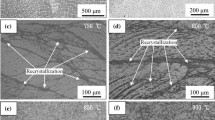Abstract
The effect of penultimate grain size on the texture of Cu-Sn alloys has been investigated using the modulus method. It was observed that in alloys which exhibited the brass-type texture, the large grained specimens yielded a smaller proportion of textured material than those which were fine grained. In alloys which exhibited transition textures, however, the larger grain size specimens exhibited a greater amount of material residing in the brass-type components. As might be expected, increasing the rolling reduction diminished the effect of penultimate grain size upon rolling. The 50:50 texture transition for 971/2 pct reduction occurred at 0.55 at. pct Sn. Unlike Cu-Zn and Cu-Al alloys, the percentage of brass-type texture reached a maximum at 1.8 at. pct Sn and then decreased for tin contents up to 5.06 at. pct. A self-consistent explanation, based on the “dislocation interaction” hypothesis, has been offered to account for the experimental observations. The present results indicate that the twinning processper se, can actually be detrimental to, rather than promote the formation of the brass-type texture in Cu-Sn alloys.
Similar content being viewed by others
References
E. O. Hall:Proc. Phys. Soc., B, 1951, vol. 64, p. 747.
N. J. Petch,J. Iron Steel Inst., 1953, vol. 174, p. 25.
I. L. Dillamore, R. E. Smallman, and W. T. Roberts:Phil. Mag., 1964, vol. 9, p. 517.
Y. C. Liu and G. A. Alers:Trans. TMS-AIME, 1966, vol. 236, p. 489.
G. A. Alers, S. S. Choi, and Y. C. Liu:Trans. TMS-AIME, 1967, vol. 239, p. 917.
G. A. Alers and Y. C. Liu:Trans. TMS-AIME, 1967, vol. 239, p. 210.
Y. C. Liu and G. A. Alers:Trans. TMS-AIME, 1969, vol. 245, p. 1857.
A. J. Baker and B. F. Peters:J. Inst. Metals, International Conference on Strength of Metals and Alloys, Tokyo, Sept. 1967, p. 919.
L. M. T. Hopkin, H. Pursey, and M. F. Markham:Z. Metallk., 1970, vol. 61, p. 535.
W. Köster and M. O. Speidel:Z. Metallk., 1965, vol. 56, p. 585.
Y. C. Liu:Trans. TMS-AIME, 1964, vol. 230, p. 656.
G. Wassermann:Z. Metallk., 1963, vol. 54, p. 61.
T. L. Johnston and C. E. Feltner:Met. Trans., 1970, vol. 1, p. 1161.
P. R. Swann:Electron Microscopy and Strength of Crystals, p. 131, John Wiley and Sons, New York, 1963.
J. E. Bailey:Electron Microscopy and Strength of Crysals, p. 535, John Wiley and Sons, New York, 1963.
Author information
Authors and Affiliations
Rights and permissions
About this article
Cite this article
Liu, Y.C., Alers, G.A. The effect of penultimate grain size on rolling texture in cu-Sn alloys. Metall Trans 4, 1491–1497 (1973). https://doi.org/10.1007/BF02667999
Received:
Issue Date:
DOI: https://doi.org/10.1007/BF02667999




